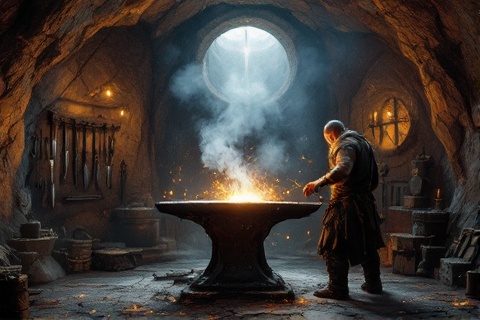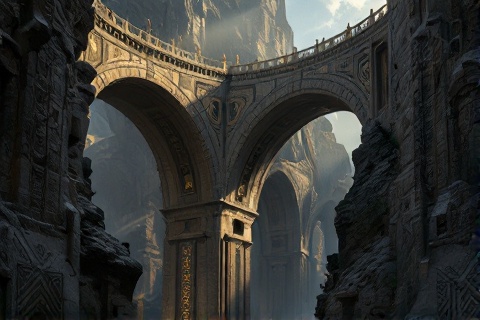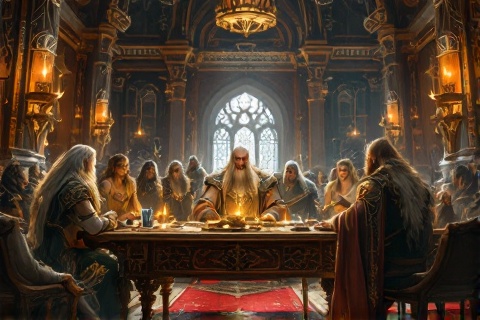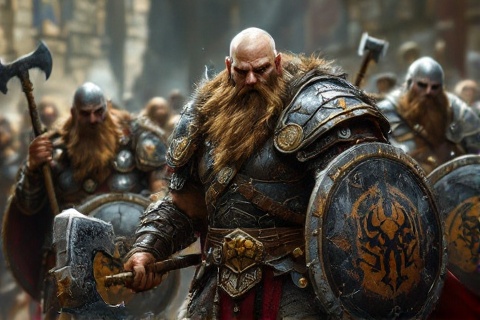
Gemstones, Greed, and Greatness: The Dwarves of Middle-earth
Unveiling the Hidden World and Enduring Legacy of Tolkien's Stoutest Folk
The Creation of the Dwarven Race

In the time before the First Age, the Vala Aulë, master of craft and making,
grew impatient waiting for the Children of Ilúvatar to awaken. His desire to
share his knowledge and craftsmanship led him to secretly create the Seven
Fathers of the Dwarves. These beings were made strong and unyielding, resistant
to domination by evil, and possessed of great skill with their hands.
When Ilúvatar discovered Aulë's creation, the Vala humbly offered to destroy his
work. However, Ilúvatar, seeing Aulë's sincere repentance and pure intentions,
chose to adopt the Dwarves as his children. This blessing granted them true
independence and free will, though they remained bound to Aulë's original design
in form and nature.
Following Ilúvatar's blessing, the Seven Fathers were put into a deep sleep by
their maker. They rested in separate places across
Middle-earth until after the first Elves
awakened at Cuiviénen. This sleep ensured that the Firstborn of Ilúvatar would
indeed be the first to walk in Middle-earth, as was intended in the Music of the
Ainur.
The Seven Houses and Their Realms
The Seven Fathers established their clans in different regions of Middle-earth,
creating distinct houses that would shape the destiny of their race. These
houses were scattered across the great mountain ranges, from the far north to
the east, each developing their own traditions while maintaining their
fundamental Dwarven nature and crafting excellence.
The Longbeards, also known as Durin's Folk, became the most
prominent and numerous of all Dwarven houses. Their greatest realm was
Khazad-dûm, called Moria by the Elves, which they
established beneath the Misty Mountains. Under the leadership of Durin I, called
the Deathless, and his descendants, this kingdom grew to become the mightiest
and most splendid of all Dwarven realms in Middle-earth.
The other six houses established themselves in various mountain ranges across
Middle-earth. The Firebeards and Broadbeams settled in the Blue Mountains, the
Ironfists and Stiffbeards in the East, and the Blacklocks and Stonefoots in the
far reaches of the Orocarni. Each house developed distinctive characteristics
and specialized crafting techniques, though less is known about these other
clans as they feature less prominently in the surviving histories.
Masters of Stone and Metal

Dwarven smiths were renowned throughout Middle-earth for their unparalleled
mastery of metalwork and stonecraft. Their techniques in working with precious
metals and gems surpassed all other peoples, and their ability to create items
of both beauty and incredible durability was legendary. The Dwarves developed
methods for crafting items that could withstand the ages, imbuing their works
with a strength and resilience that reflected their own nature.
Among the most famous works of Dwarven craft were the mithril-mail shirt worn by
Bilbo and later Frodo, and the magnificent Doors of
Durin at the west entrance of Khazad-dûm. The mithril coat, light as a feather
yet harder than dragon scales, exemplified their mastery of
precious metals, while the Doors showcased their ability to work with ithildin
and create mechanisms of incredible complexity.
The secrets of Dwarven craftsmanship were carefully guarded and passed down
through generations within their families and guilds. Their techniques for
tempering metal, setting gems, and working stone were never shared with
outsiders. The Dwarves developed their own unique tools and methods, including
the use of runes to enhance their crafts, and their workshops were places of
closely guarded knowledge where masters would teach their apprentices the
ancient ways of their craft.
The Glory of Khazad-dûm

Khazad-dûm was established in the First Age by Durin I, who awakened at Mount
Gundabad and journeyed south to the Misty Mountains. There he founded what would
become the greatest kingdom of the Dwarves, spanning the entire width of the
mountain range with its many halls, chambers, and mines. During its peak,
Khazad-dûm was a marvel of engineering and architecture, with multiple levels
extending deep into the mountain.
The discovery of mithril beneath the foundations of Khazad-dûm brought
unprecedented wealth and power to Durin's Folk. This precious silver-steel was
more valuable than gold, stronger than any other metal, and could be beaten like
copper while maintaining its strength. The presence of mithril made Khazad-dûm
the wealthiest and most powerful of all Dwarven realms.
The architectural achievements of Khazad-dûm showcased the height of Dwarven
ingenuity. The city featured vast halls with soaring columns, intricate stone
carvings, and sophisticated systems for ventilation and lighting. The Dwarves
created innovative mechanisms for opening doors, moving heavy objects, and
defending their realm, while their mining operations demonstrated advanced
understanding of geology and engineering.
The glory of Khazad-dûm came to an end in the Third Age when the Dwarves delved
too deeply and awakened a Balrog, known as Durin's
Bane. This ancient demon slew King Durin VI and his son
Náin I, forcing the Dwarves to abandon their greatest realm. The fall of
Khazad-dûm marked a turning point in Dwarven history, leading to their dispersal
and the loss of many ancient crafts and techniques.
Language and Written Legacy
Khuzdul, the secret language of the Dwarves, was created for them by Aulë
himself and remained largely unchanged throughout their history. The Dwarves
guarded their language zealously, teaching it only to their own kind and using
it primarily for their private affairs. Even their names in Khuzdul were kept
secret from non-Dwarves, with most using names in the languages of other peoples
for public use.
The Cirth runes, though originally developed by the Sindar
Elves, were adopted and modified by the Dwarves to better suit their needs in
recording their crafts and histories. The Dwarves refined these runes into the
Angerthas Moria and later the Angerthas Erebor, using them
extensively for inscriptions on stone and metal, as well as in their books of
lore.
The Dwarves maintained detailed written records of their histories, genealogies,
and craft-knowledge in great books of lore. These records were kept in protected
libraries within their mountain halls, carefully preserved and copied by
dedicated loremasters. The combination of their secret language and runic script
allowed them to maintain their cultural heritage and technical knowledge through
the ages.
Relations with Other Races

The relationship between Dwarves and Elves was marked by both great friendship
and bitter rivalry throughout the Ages. The greatest example of cooperation
between the two races occurred in the Second Age, when the
Dwarven smiths of Khazad-dûm worked alongside the Elven-smiths of
Eregion. This partnership resulted in many great works,
including the Doors of Durin, which bore inscriptions in both Elvish and
Dwarvish.
The Dwarves established important trading relationships with the societies of
Men, particularly the Northmen and the men of Dale near Erebor.
These partnerships were built on mutual benefit, with Dwarves trading their
crafts and metalwork for food, textiles, and other goods they could not produce
in their mountain homes. The men of Dale and Esgaroth became
particularly prosperous through their trade with the Dwarves of Erebor.
Despite their trading relationships, Dwarven society remained largely isolated
and secretive. They rarely shared their crafting techniques or allowed outsiders
into their mountain halls beyond designated trading areas. This isolation helped
preserve their culture and traditions but also contributed to misunderstandings
and prejudices between Dwarves and other races.
Warriors and Weapons of Legend

Dwarven warriors were renowned for their fighting prowess, particularly in close
combat with axes and heavy weapons. Their natural strength and endurance,
combined with their craftsmanship in arms and armor, made them formidable
opponents. Dwarven warriors typically wore heavy mail and plate armor of their
own making, which provided excellent protection while allowing them to move with
surprising speed and agility in battle.
Throughout their history, Dwarves participated in many significant battles and
campaigns. They fought alongside Elves and Men in the War of the Last Alliance,
demonstrated their valor in the Wars of the Dwarves and Orcs, and
played crucial roles in the Battle of Five
Armies. The War of the Dwarves and Orcs, sparked
by the murder of Thrór, showcased their military might as they systematically
cleared the Misty Mountains of Orcs.
The defensive capabilities of Dwarven strongholds were legendary, incorporating
sophisticated engineering and natural mountain features. Their gates were nearly
impenetrable, their walls immensely thick, and their halls designed with defense
in mind. They created elaborate systems of tunnels, gates, and killing zones
that made their fortresses extremely difficult to capture by force.
Cultural Heritage and Traditions
Beards held immense cultural significance in Dwarven society, serving as symbols
of pride, honor, and authority. Dwarves began growing their beards from a young
age, and the length and elaborateness of one's beard often indicated their
status and experience. They would weave elaborate braids and decorations into
their beards, sometimes incorporating precious metals and gems for special
occasions.
The naming customs of Dwarves were complex and rooted in ancient traditions.
Each Dwarf had both a public name used in dealings with other races and a secret
name in Khuzdul known only to their own people. Dwarven women, who made up about
one-third of their population, were rarely seen by outsiders and were nearly
indistinguishable from male Dwarves in appearance and dress when they did
travel.
The passing of craft and lore through generations was a fundamental aspect of
Dwarven culture. Young Dwarves would apprentice under master craftsmen, learning
not only the technical skills of their craft but also the ancient lore and
traditions associated with it. This system ensured the preservation of their
crafting techniques and cultural heritage through the ages.
Dwarven society celebrated numerous festivals and ceremonies throughout the
year, many of which were connected to their crafts and ancestors. These included
ceremonies marking the beginning of new mining operations, celebrations of great
crafting achievements, and solemn observations of historical events. During
these occasions, Dwarves would gather in their great halls for feasting,
singing, and the recitation of ancient tales.
The Quest for Erebor

The arrival of Smaug at the Lonely Mountain in 2770 of the
Third Age marked a catastrophic turning point for Durin's Folk. The dragon's
attack was swift and devastating, driving the Dwarves from their wealthy kingdom
and scattering them across Middle-earth. The loss of Erebor not only deprived
the Dwarves of their riches but also of their ancestral home and many of their
ancient treasures.
In 2941, Thorin Oakenshield led a company of
twelve Dwarves, along with the hobbit Bilbo Baggins and the
wizard Gandalf, on a quest to reclaim Erebor. Their
journey, chronicled in The Hobbit, involved numerous perils
including encounters with trolls, goblins, and spiders, as well
as negotiations with the Elves of Mirkwood and the men
of Lake-town. The quest ultimately succeeded in defeating Smaug, though at great
cost.
Following the Battle of Five Armies and the death of Thorin Oakenshield, his
cousin Dáin Ironfoot became King under the Mountain. Under Dáin's rule, Erebor
was restored to its former glory, and the Dwarves reestablished their powerful
presence in the north. The kingdom prospered until the War of the Ring, during
which Dáin fell defending the body of his ally King Brand of Dale against
Sauron's forces.
